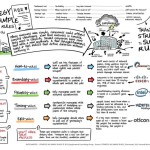When we face complexity, we have a choice between a simple solution and a complex solution.
Donald Sull
 Over the last few months, I made a dent in my book reading list and now have a sizable backlog of potential blogs. One book I particularly enjoyed was ‘Simple Rules: How to Thrive in a Complex World’ by Donald Sull and Kathleen Eisenhardt. The authors use a wide range of examples – from medical care to college football to complexity theory – to show that simple rules often lead to better outcomes than complex analysis. A simple example of a simple rule: burglars reduce the likelihood of being caught by avoiding houses with a car parked outside.
Over the last few months, I made a dent in my book reading list and now have a sizable backlog of potential blogs. One book I particularly enjoyed was ‘Simple Rules: How to Thrive in a Complex World’ by Donald Sull and Kathleen Eisenhardt. The authors use a wide range of examples – from medical care to college football to complexity theory – to show that simple rules often lead to better outcomes than complex analysis. A simple example of a simple rule: burglars reduce the likelihood of being caught by avoiding houses with a car parked outside.
Simple rules work because they are easy to remember; “when information is limited and time is short, simple rules make it fast and easy for people […] to make sound choices.” Simple rules provide consistency for teams but allow for some flexibility to pursue new opportunities or explore boundary conditions. From this point of view, I think of these rules as heuristics – mental shortcuts that reduce our cognitive load when making a decision. As I learned more than 30 years ago from the classic textbook ‘Judgment Under Uncertainty’, heuristic methods are best used when finding an optimal solution is impractical. The authors provide this explanation:
Simple rules are shortcut strategies that save time and effort by focusing our attention and simplifying the way we process information. The rules aren’t universal — they’re tailored to the particular situation and the person using them.
With so many compelling examples of how simplicity is better than complexity, the authors provide some guidelines on what makes a good set of simple rules. Here is their advice:
- Limit to a handful. Capping the number of rules makes them easy to remember and maintains a focus on what matters most.
- Tailor to the person or organization using them. College athletes and middle-aged dieters may both rely on simple rules to decide what to eat, but their rules will be very different.
- Apply to a well-defined activity or decision. Rules that cover multiple activities or choices end up as vague platitudes, such as “Do your best” and “Focus on customers.”
As I wrote last year, Complexity Kills. Simple rules are one weapon to kill complexity.
This blog was originally posted on Manage by Walking Around on October 18, 2015.
Please follow me on Twitter, LinkedIn, and Google+.
